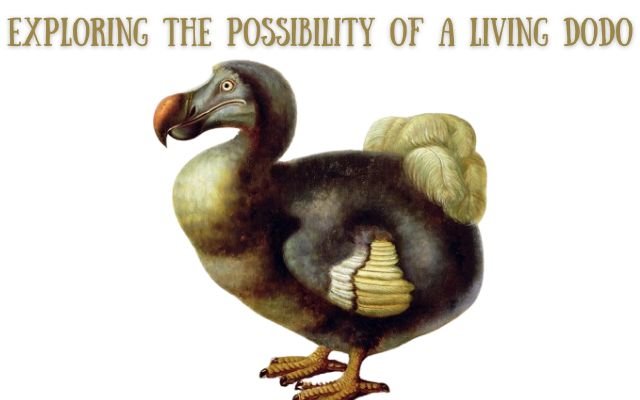Is the Dodo Really Extinct? A New Theory
Is the Dodo really extinct? A new theory explores misconceptions, revealing surprising insights about the Dodo's true nature and extinction.

Dodo is often seen as a slow and unintelligent bird destined for extinction but new research proves this idea wrong. Scientists from the University of Southampton, Natural History Museum and Oxford University have found that Dodo was actually a well-adapted bird.
In a study published on August 16 in the Zoological Journal of the Linnean Society, researchers reviewed the Dodo’s classification, along with its close relative, the Rodriguez Island Solitaire. This study corrected many long-held myths and misconceptions.
They examined 400 years of scientific work and visited collections around the UK to ensure this species, often seen as a symbol of human destruction, is now properly understood and classified.
Setting the Record Straight: Correcting Historical Misconceptions
Dr. Neil Gostling from the University of Southampton explains, “The Dodo was the first species humans observed to exist and then go extinct. Before this, people didn’t believe humans could impact nature so drastically.”
“This was a time before modern science and classification systems existed. The Dodo and the Solitaire went extinct before we fully understood them.”
Misunderstandings and Myths
Most information about the Dodo and the Solitaire came from Dutch sailors’ stories, artists’ drawings, and incomplete remains.
Because there was no clear reference point or naming system for species, many misidentifications occurred after these birds went extinct. New names like the Nazarene Dodo, the White Dodo, and the White Solitaire were created but research shows that none of these actually existed. Still, these mistakes caused confusion in zoological studies.
Clarifying Species Confusion
Dr. Mark Young from the University of Southampton explains, “By the 18th and early 19th centuries, many thought the Dodo and the Solitaire were just myths. It was the hard work of Victorian scientists who showed that these birds were real and were actually large ground doves.”
He adds, “Sadly, no one could agree on how many species there were. For most of the 19th and 20th centuries, some researchers believed there were three species, while others thought there might be four or even five.”
To clear up this confusion, the researchers reviewed hundreds of accounts about the Dodo and Rodriguez Solitaire going back to 1598 and examined specimens in the UK, including the only surviving soft tissue from the Dodo at the Oxford Museum.
Listen to audio snippets of Dr. Neil Gostling discussing the research. Credit: University of Southampton.
Dr. Julian Hume, an avian paleontologist at the Natural History Museum and coauthor of the paper, says, “More has been written about the Dodo than any other bird, yet we know very little about how it lived.”
He adds, “After 400 years since its extinction, the Dodo and Solitaire still spark debate due to confusion in naming. We’ve traced how early ideas evolved and tried to correct the record as much as possible.”
The researchers confirmed that both birds belong to the columbid family, which includes pigeons and doves.
Dr. Gostling explains, “Understanding how these birds relate to other pigeons is important for classification. However, from a conservation viewpoint, the extinction of the Dodo and the Solitaire means we lost a unique part of the pigeon family tree. No other birds like these giant ground doves exist today.”
Uncovering the Dodo’s Real Identity
The researchers argue that the common belief of the Dodo being a fat, slow bird doomed to extinction is inaccurate.
“Even after 400 years, we still have much to learn about these fascinating birds,” says Dr. Young. “Was the Dodo really as slow and dumb as we’ve been told? Some accounts describe it as a fast-moving bird that thrived in forests.”
Dr. Gostling adds, “Bone evidence suggests the Dodo had strong tendons, similar to today’s climbing and running birds. It was likely a very active and fast animal.”
“These birds were well-suited to their environment, but their islands had no mammal predators. When humans brought rats, cats, and pigs, the Dodo and Solitaire couldn’t survive.
“Dodos played a key role in their ecosystems. By studying them, we may find ways to help restore the ecosystem in Mauritius and begin reversing the damage caused by humans 500 years ago.”
Future Conservation and Research
The study is just the start of a larger project to learn more about the Dodo and its relatives.
Dr. Markus Heller, a professor of biomechanics at the University of Southampton, says, “We’re about to uncover the mysteries of the Dodo bird.” He mentions that the team of scientists is dedicated to finding out more about this famous extinct bird. Their research might also help protect endangered birds today.
Dr. Heller explains, “We’re using advanced computer technology to understand how the Dodo lived and moved. This isn’t just for curiosity; it can teach us important lessons about protecting birds now.”
He compares it to solving a long-standing puzzle that might help prevent other birds from going extinct.
The project will also work with paleoartist Karen Fawcett, who is creating a life-size model of the Dodo. She says, “This combines science and art to make these creatures feel real and tangible for people to see and touch.”
- Can You Handle It? The World’s Hottest Places
- Gorillas’ Herbal Remedies: A Natural Cure for Human Diseases?
- 50 Science Facts That Will Shock You
FAQ
1. Why is the Dodo often seen as a slow and unintelligent bird?
The Dodo has long been portrayed as a slow and dumb animal, mainly because of how it was described in historical records and art. However, recent research suggests that this image is not accurate. The Dodo was likely an active and fast-moving bird.
2. What new research has been done about the Dodo?
A study published by scientists from the University of Southampton, the Natural History Museum, and Oxford University reviewed 400 years of scientific literature. They corrected many myths about the Dodo and its close relative, the Rodriguez Island Solitaire.
3. What did the researchers discover about the Dodo and the Solitaire?
The researchers confirmed that both the Dodo and the Solitaire were large ground doves and not slow or unintelligent. They belonged to the columbid family, which includes pigeons and doves. The study also cleared up confusion about how many species existed.
4. Why did the Dodo and Solitaire go extinct?
The Dodo and Solitaire were well-adapted to their environment, but their islands had no mammal predators. When humans arrived, bringing animals like rats, cats, and pigs, these birds couldn’t survive, leading to their extinction.
5. How does this research help us today?
Understanding the biology and role of the Dodo in its ecosystem can help in conservation efforts. Researchers believe that by studying the Dodo, they can find ways to help restore ecosystems in places like Mauritius and protect endangered birds today.
6. What is the future of Dodo research?
The current study is part of a larger project that aims to understand how the Dodo lived and moved. Using advanced technology, scientists hope to learn lessons that can be applied to protect modern bird species.
7. What role does art play in this research?
Paleoartist Karen Fawcett is creating a life-size model of the Dodo, blending science and art to bring the extinct bird back to life, so people can better visualize and understand what the Dodo was like.



